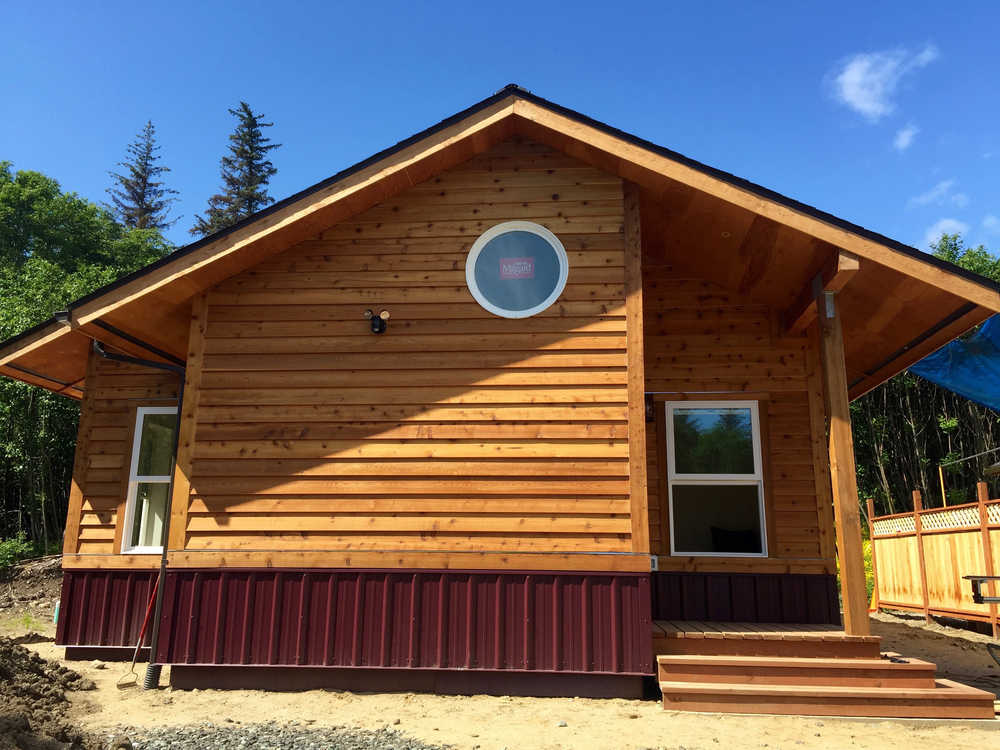Sydne Williamson wants to build houses — “tiny houses.”
“I’m proficient at demolition,” she said while taking measurements for some exterior finish work on a 900-square foot home under construction. “But I need to learn how to build. I see tiny houses as a low-cost housing need for Juneau. I think people are ready to get rid of their material things.”
Williamson was among University of Alaska Southeast and Juneau-Douglas High School students working on a low-cost housing project through the University’s School of Career Education, in partnership with Juneau Housing Trust, over the past school year out the road near Lena Point.
A young family will move into the house this summer. A second home next door will be completed by students during the Fall 2016 semester.
UAS Career Education features a diverse selection of pursuits including construction technology, welding, nursing, mining and power technology, which includes work on diesel trucks and equipment.
The department gears its course work toward college and high school students eyeing careers that might not call for a four-year degree while training in a college setting. Graduates receive an Associate of Applied Science degree.
“This is increasingly better for the university and the students,” executive dean for the School of Career Education Pete Traxler said. “And it replaces the lack of community colleges in Alaska with the mission statement of a four-year university. People are looking at more skills to make their resume stronger and raise their ranking as far as employability. We’re poised in a good way to be able to help them.”
For Williamson, this is her third construction class. On this day, she works on an exterior finish task in the front of the house, after getting a briefing from Associate Professor Justin Fantasia.
Fantasia leaves students to their work while he prepares the next step, already outlined on a white board upon their arrival.
“This gives them a good exposure to the actual tasks they’ll be doing,” Fantasia said. “The part that usually causes the most trouble if somebody wants to go into the trades is the basic work ethic, like showing up on time for 8-12 hour days.”
With each nail pounded, each section of roof in place and each window fitted, the houses become the university’s most visible sign of the program.
About 13 miles south stands a building along Gastineau Channel and connected by a pedestrian overpass to Juneau-Douglas High School. Once used for shipbuilding, the Technical Education Center (TEC) building is undergoing an incremental $5 million renovation. The TEC houses programs including:
• Health sciences classes: The newly renovated nursing lab is home to a nursing and certified nursing assistant program, plus first aid and CPR classes. “It’s busy all of the time, 8 a.m. to 11 p.m.,” Traxler said. “The state is definitely getting its money’s worth.”
• A power tech diesel facility with a high bay door to bring in diesel trucks. Here high school students can take preparatory classes and continue in the auto program at the University’s Anchorage campus. Classes range from engine work to brakes to hydraulics.
• A mining training center. With Kensington Mine arriving several years ago and Greens Creek in operation, the demand for specialized workers continues.
“Career education is driven by what industry needs,” Traxler said. “Obviously here are two big factors: Greens Creek and Kensington.
The TEC building is undergoing a reallocation of existing footage to make it more suitable for learning. As many as 300 part-time and full-time students are enrolled in Career Ed classes. Many come from various Southeast communities. But the program also has a statewide draw, attracting students from Anchorage, Fairbanks and Interior towns. Students are taught by instructors who have built careers in the field. Some are retired. Others remain active. All speak from experience and with an understanding that the students want to learn but may not immediately seek a four-year degree.
“Our faculty are not your typical faculty,” Traxler said. “They are born and raised blue collar usually. They are willing to work hard. Most I have to tell to go home. That’s the easiest part of my job. We can make more money somewhere else, but we are here to give something to the next generation.”
Back on the construction sites near Auke Bay, these two starter homes are built by young hands. Depending on the day of the week at the work site, there could be a handful of students, or large groups reminiscent of a traditional Amish barn-raising.
“From the university’s standpoint, better learning is always good for our students, and that’s what you have here,” Traxler said. “It’s way more work to do something in the field than to build something in a lab, and great experience. It’s more applicable when you can work in a real-world setting, building houses people will live in for the next 100 years.”

